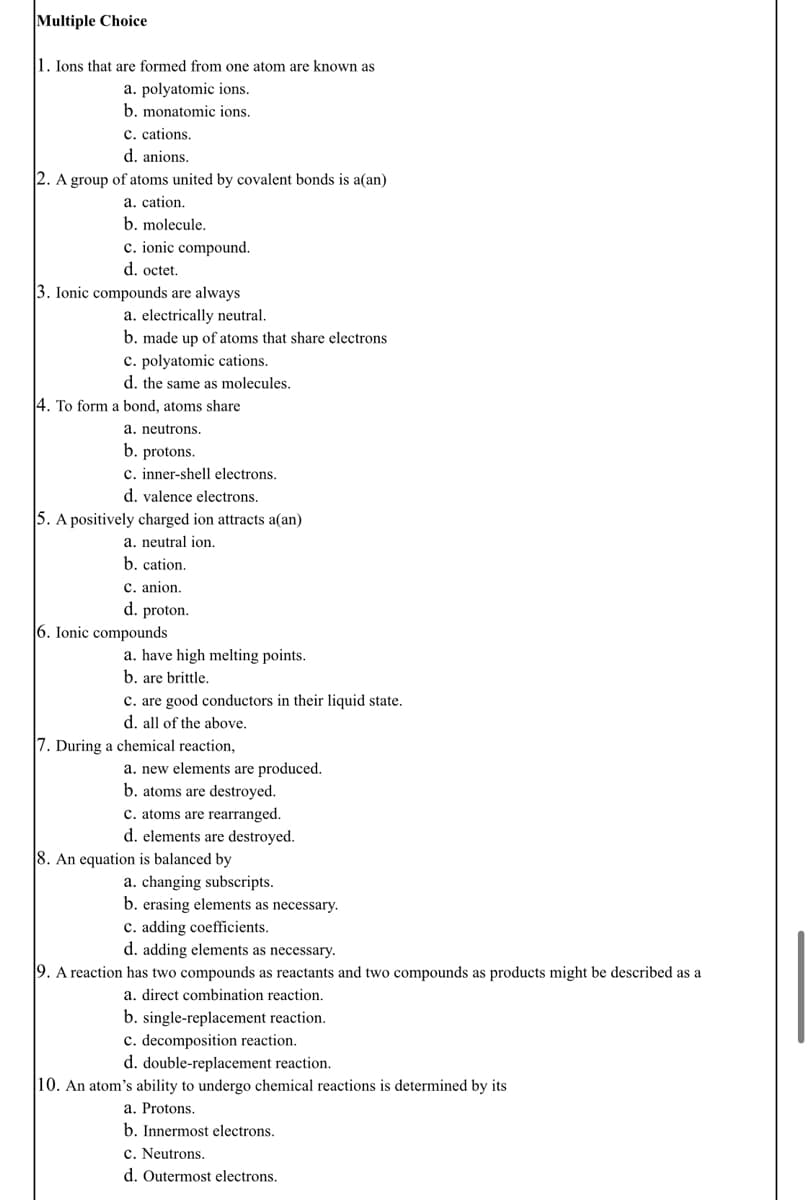1. Ions that are formed from one atom are known as a. polyatomic ions. b. monatomic ions. c. cations. d. anions. 2. A group of atoms united by covalent bonds is a(an) a. cation. b. molecule. c. ionic compound. d. octet. 3. Ionic compounds are always a. electrically neutral. b. made up of atoms that share electrons c. polyatomic cations. d. the same as molecules.
1. Ions that are formed from one atom are known as a. polyatomic ions. b. monatomic ions. c. cations. d. anions. 2. A group of atoms united by covalent bonds is a(an) a. cation. b. molecule. c. ionic compound. d. octet. 3. Ionic compounds are always a. electrically neutral. b. made up of atoms that share electrons c. polyatomic cations. d. the same as molecules.
Chapter4: Molecules, Compounds, And Chemical Reactions
Section: Chapter Questions
Problem 61E
Related questions
Question

Transcribed Image Text:Multiple Choice
|1. Ions that are formed from one atom are known as
a. polyatomic ions.
b. monatomic ions.
c. cations.
d. anions.
2. A group of atoms united by covalent bonds is a(an)
a. cation.
b. molecule.
c. ionic compound.
d. octet.
3. Ionic compounds are always
a. electrically neutral.
b. made up of atoms that share electrons
c. polyatomic cations.
d. the same as molecules.
4. To form a bond, atoms share
a. neutrons.
b. protons.
c. inner-shell electrons.
d. valence electrons.
5. A positively charged ion attracts a(an)
a. neutral jon.
b. cation.
c. anion.
d. proton.
6. Ionic compounds
a. have high melting points.
b. are brittle.
c. are good conductors in their liquid state.
d. all of the above.
7. During a chemical reaction,
a. new elements are produced.
b. atoms are destroyed.
c. atoms are rearranged.
d. elements are destroyed.
|8. An equation is balanced by
a. changing subscripts.
b. erasing elements as necessary.
c. adding coefficients.
d. adding elements as necessary.
9. A reaction has two compounds as reactants and two compounds as products might be described as a
a. direct combination reaction.
b. single-replacement reaction.
c. decomposition reaction.
d. double-replacement reaction.
10. An atom's ability to undergo chemical reactions is determined by its
a. Protons,
b. Innermost electrons.
c. Neutrons.
d. Outermost electrons.
Expert Solution
This question has been solved!
Explore an expertly crafted, step-by-step solution for a thorough understanding of key concepts.
Step by step
Solved in 4 steps

Knowledge Booster
Learn more about
Need a deep-dive on the concept behind this application? Look no further. Learn more about this topic, chemistry and related others by exploring similar questions and additional content below.Recommended textbooks for you


Introductory Chemistry: A Foundation
Chemistry
ISBN:
9781337399425
Author:
Steven S. Zumdahl, Donald J. DeCoste
Publisher:
Cengage Learning

Chemistry: Principles and Reactions
Chemistry
ISBN:
9781305079373
Author:
William L. Masterton, Cecile N. Hurley
Publisher:
Cengage Learning


Introductory Chemistry: A Foundation
Chemistry
ISBN:
9781337399425
Author:
Steven S. Zumdahl, Donald J. DeCoste
Publisher:
Cengage Learning

Chemistry: Principles and Reactions
Chemistry
ISBN:
9781305079373
Author:
William L. Masterton, Cecile N. Hurley
Publisher:
Cengage Learning

Chemistry & Chemical Reactivity
Chemistry
ISBN:
9781133949640
Author:
John C. Kotz, Paul M. Treichel, John Townsend, David Treichel
Publisher:
Cengage Learning

Chemistry & Chemical Reactivity
Chemistry
ISBN:
9781337399074
Author:
John C. Kotz, Paul M. Treichel, John Townsend, David Treichel
Publisher:
Cengage Learning

Chemistry for Engineering Students
Chemistry
ISBN:
9781337398909
Author:
Lawrence S. Brown, Tom Holme
Publisher:
Cengage Learning